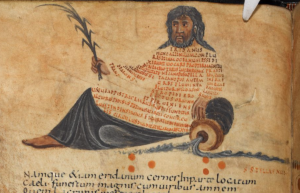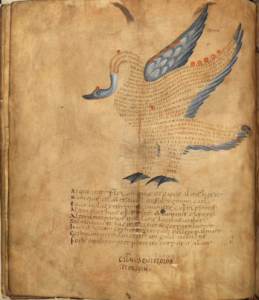
When I first selected this class over seven months ago, I felt like it was a course I couldn’t pass up. I saw it as a fantastic opportunity to learn more about librarianship and the history of books. Medieval manuscripts are older than anything I had ever handled before, by hundreds of years even, and, well, they just aren’t something you see every day. However, I never considered the bearing it would have on my classical languages major. In the first few weeks of class, during our efforts of learning script styles and transcription, I was pleasantly surprised. Many of the manuscripts and fragments we were studying were written in Latin. Before this course, I knew in the back of my head that many of the Middle Ages’ religious texts were written in medieval Latin, but somehow that fact had never sunk in until I experienced it firsthand.
From then on, I was able to connect our study of manuscripts to classical languages and history in a way that I had never expected. It was an amazing new experience to see how people from hundreds of years ago, but not as far back as antiquity, used and interacted with ancient Greek and Latin languages, whether through classical texts or their own religious documents. For example, medieval abbreviations of Latin words is a topic that I never knew existed until I had to decipher them while transcribing medieval scripts. I doubt I ever would have encountered it in any other class.
Even during our research of medieval pigments this unit, I found connections to classical history and authors. Lead white, the cheapest and most common source of white pigment for medieval artists, was created using recipes like ones documented by notable Roman and Greek writers. In his Natural History, written around 77 A.D., Pliny the Elder said that “the lead is thrown into jars filled with vinegar, which are kept closed for ten days; the sort of mould that forms upon the surface is then scraped off, and the lead is again put into the vinegar, until the whole of the metal is consumed” [1].
Greek botanist Theophrastus, Roman architect Vitruvius, and Greek historian Xenophon also mentioned the creation of lead white pigment through this process [2; 3]. Their descriptions are nearly identical to the “stack” method that medieval pigment-makers would have used. It was a good reminder that medieval manuscripts didn’t exist in a vacuum. They took inspiration from the people who came before them, just as we do in studying their works.

One particular manuscript that stood out to me early on for its connection to classical antiquity was the British Library’s Harley MS 647. The manuscript was compiled between the 9th and the 11th centuries in England and France. It contains several astronomical and astrological texts, including Cicero’s Aratea and Hyginus’s Astronomica. Notably, Hyginus’s work is made into 22 pages of carmina figurata, where the text is shaped to create the various constellations detailed in the Astronomica. Medieval readers of this manuscript, therefore, could have used it in a variety of ways. Those interested in the scientific nature of astrology and astronomy had Hyginus’s prose to learn from, while those more suited to the Greco-Roman myths of the origins of the constellations had Cicero’s poetry. Even if someone couldn’t read the manuscript, they could still use the illustrations, where the stars are marked as orange dots, to identify the constellations in the sky. Harley MS 647 is a wonderful example of classical works and medieval scribes and artists coming together over the passage of time to create something that we can still enjoy today. Plus, it has a little bit for everyone, then and now.
Essentially, the study of medieval manuscripts over these past few months have revealed to me a new way of thinking about classical languages and history. The writings of classical authors are essential sources of these languages that have survived over the years due to copies passed down in medieval manuscripts, such as the Aratea and Astronomica in Harley MS 647. In the case of medieval lead white pigment, a connection can exist between the classical authors and medieval people beyond the text of the manuscript itself. Therefore, instead of being removed from classical subjects entirely, manuscripts provide a fascinating glimpse into the ways another group of people, more recent than classical times but older than modern-day scholars, interacted with classics themselves.
– Alexandra Carlsrud
Works Cited
[1] See Pliny the Elder, Natural History, trans. and ed. John Bostock and H.T. Riley; book 34, chapter 54.
[2] For Vitruvius and Theophrastus: see Rutherford J. Gettens, Hermann Kühn, and W.T. Chase, “Lead White” in Artists’ Pigments: A Handbook of their History, vol. 2, ed. Roy Ashok (Washington: National Gallery of Art, 1986), page 68.
[3] For Xenophon: see Alvah Horton Sabin, White-Lead: Its Use in Paint (Brooklyn: Brownworth & Co., 1920), page 1.